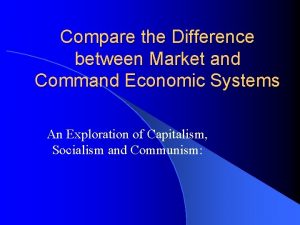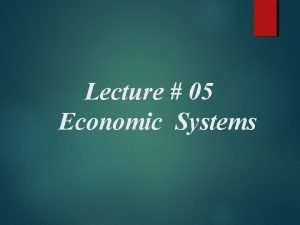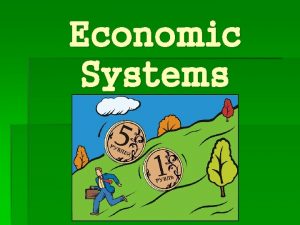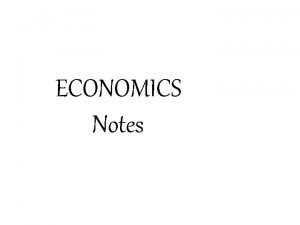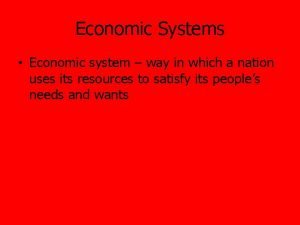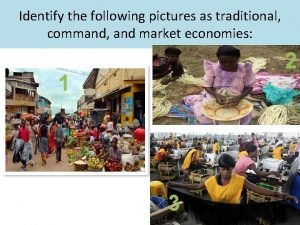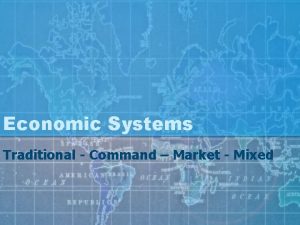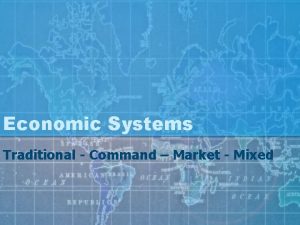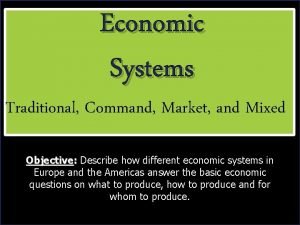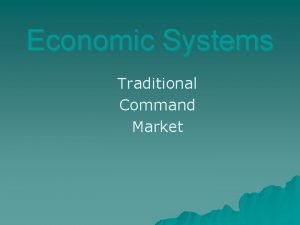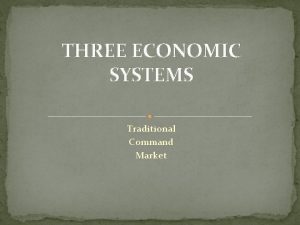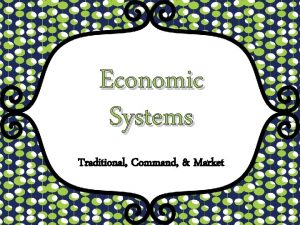Economic Systems Traditional Command Mixed and Market Systems








- Slides: 8

Economic Systems Traditional, Command, Mixed and Market Systems

Traditional • Economic decisions repeat those made in earlier times. • Based on custom and tradition • Children follow in parents footsteps • Tradition dictates how and when things will be produced – plant corn when oak leaves are the size of a squirrels ear • Social units share goods and trade

Command • Economic decisions are made by the gov’t • Planners decide what to produce, how to produce and for whom to produce • Command decisions can be democratic or authoritarian • Individuals have little or no choice • Middle Ages, Ancient Egypt – monarchs controlled what would be produced

Market • Decisions are made by people engaged in • • • voluntary exchanges. Consumers determine what to produce. Producers determine how to produce. Income depends on the productive resources a person has to sell. Market prices are signals that effect consumption and production. Government has little or no say in production.

Command Economies Market Economies • Government Ownership of • Private ownership of all • • • all nonhuman resources Primary allocation of resources determined by central planners Income equality promoted by wages set by planners. Zero Unemployment types of resources • Market prices direct products and resources • Income depends on the • resources an individual has to sell. Some forms of unemployment are tolerated.

Command • State enterprises never • fail due to subsidies, permission to raise prices or exemption from taxes. Central planners make producation decisions to meet social goals, with limited consideration of Market • People change jobs, • changes in skills sought by employers, cyclical and seasonal fluctuations Consumer demand is the driving force behind firms’ production decision

Command • Limited foreign trade to maintain econ independence • Prices usually set below market clearing price to ensure goods are sold and control officially measured inflation. Market • International specialization promotes competition and holds production costs and prices down • Prices adjust to keep consumption and production at market equilibrium levels.

Mixed Economies • Combines elements of traditional, market and command • econ models (3 types) Authoritarian socialism (communism) – Gov’t plans & owns everything in production • Capitalism – Individuals factors of production – Some gov’t regulation – limited – Provide some social services, ed, defense • Democratic socialism – – – Gov’t owns factors of production and key industries Individuals elect officials who plan Some market with individual businesses encouraged
 Chapter 1 lesson 2 our economic choices worksheet answers
Chapter 1 lesson 2 our economic choices worksheet answers International segmentation
International segmentation Similarities between market and command economy
Similarities between market and command economy Market leader market challenger market follower
Market leader market challenger market follower Characteristics of mixed economic system
Characteristics of mixed economic system Mixed economic system
Mixed economic system Command economy pictures
Command economy pictures Command economy
Command economy Traditional economy pictures
Traditional economy pictures


